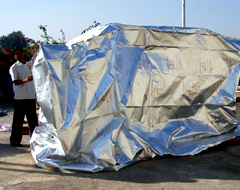Vacuum packing or vacuum packaging is a method of packaging that removes air from the
package prior to sealing. It can involve both rigid and flexible types of packaging. The intent
is usually to remove oxygen from the container to extend the shelf life of foods and, with
flexible package forms, to reduce the volume of the contents and package.
Vacuum packing reduces atmospheric oxygen, limiting the growth of aerobic bacteria or
fungi, and preventing the evaporation of volatile components. It is also commonly used to
store of dry foods over a long period of time, foods such as cereals, nuts, cured meats,
cheese, smoked fish, coffee, and potato chips (crisps). On a more short term basis, vacuum
packing can also be used to store fresh foods, such as vegetables, meats, and liquids,
because they inhibit bacterial growth.
Vacuum packing greatly reduces the bulk of non-food items. For example, clothing and
bedding can be stored in bags evacuated with a domestic vacuum cleaner or a dedicated
vacuum sealer. This technique is sometimes used to compact household waste, for example
where a charge is made for each full bag collected.
Vacuum packaging products using
machinery, lab instruments, articles and coated product.
